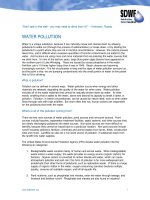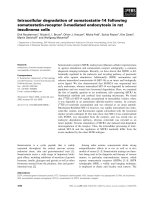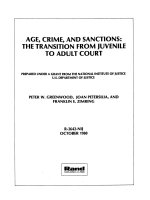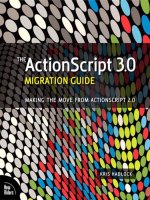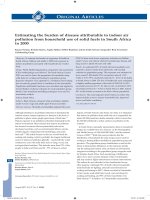Making the transition from s7 200 to s7 1200
Bạn đang xem bản rút gọn của tài liệu. Xem và tải ngay bản đầy đủ của tài liệu tại đây (2.22 MB, 48 trang )
Page 1
S7-1200 Transition Manual © Siemens AG 11/2009. All Rights Reserved.
A5E02486860-01 Industry Sector
© Siemens AG 11/2009. All Rights Reserved.
Making the transition
from S7-200 to S7-1200
Notes are available to supplement this presentation. To view the notes, select View > Notes Page
or print the presentation with the Print > Print what: > Notes Pages option.
S7-1200 and STEP 7 Basic
The S7-1200 is the successor of the S7-200 and is available in June 2009. It is designed for and will
be sold in the world wide market place.
The S7-200 will remain an active Siemens product.
STEP 7 Basic v10.5 programming package (ordered separately) is used with the S7-1200
- Supports LAD and FBD. STL is not supported.
- Includes WinCC Basic for configuring HMI Basic panels.
- No separate USB license stick is required. The software is automatically activated when installed.
An export-import function for an S7-1200 project is not available in the initial release. To move
project files from one PC to another PC, use the Windows explorer and PKZIP to copy the project files
directory structure.
S7-1200 Approvals
S7-1200 hardware has the necessary approvals for the US and European market.
The S7-1200 has FM approval for hazardous location:
The Factory Mutual Research (FM): Approval Standard Class Number 3600 and 3611
Approved for use in:
- Class I, Division 2, Gas Group A, B, C, D, Temperature Class 40° C
- Class I, Zone 2, IIC, Temperature Class T4 Ta = 40° C
The S7-1200 hardware has UL and CE approvals.
Page 2
S7-1200 Transition Manual © Siemens AG 11/2009. All Rights Reserved.
A5E02486860-01 Industry Sector
S7-1200 Transition Manual © Siemens AG 11/2009. All Rights Reserved.
A5E02486860-01 Industry Sector
Page 2/48
Technology
Timers
Counters
Block concept
Memory
HMI
Communication
Hardware
System Expandability
7 (EM + CP) maximum
8 SM maximum
3 CM (Communication Module) maximum
S7-200
S7-1200
CPU
EM (Expansion Module)
CP (Communication Processor)
CPU SM (Signal Module)CM
Instruction set
New data types
Resources
CPU 1214C DC/DC/Relay
CPU 1214C AC/DC/Relay
CPU 1214C DC/DC/DC
2 IN (0-10V)14 IN -10 OUTCPU 1214C
CPU 1212C DC/DC/Relay
CPU 1212C AC/DC/Relay
CPU 1212C DC/DC/DC
2 IN (0-10V)
8 IN – 6 OUTCPU 1212C
CPU 1211C DC/DC/Relay
CPU 1211C AC/DC/Relay
CPU 1211C DC/DC/DC
2 IN (0-10V)6 IN - 4 OUTCPU 1211C
Power, Signal IN, Signal OUT CPU Analog INCPU Digital I/OS7-1200 CPU
SB 1232 1 Analog Output
SB 1223 2 x 24 VDC Input / 2 x 24 VDC Output
Signal Boards
SM 1234 4 x Analog Input / 2 x Analog Output
SM 1232 2 x Analog Output
SM 1231 4 x Analog Input
SM 1223 16 x 24 VDC Input / 16 x Relay Output
SM 1223 8 x 24 VDC Input / 8 x Relay Output
SM 1223 16 x 24 VDC Input / 16 x 24 VDC Output
SM 1223 8 x 24 VDC Input / 8 x 24 VDC Output
SM 1222 16 x Relay Output
SM 1222 8 x Relay Output
SM 1222 16 x 24 VDC Output
SM 1222 8 x 24 VDC Output
SM 1221 16 x 24 VDC Input
SM 1221 8 x 24 VDC Input
Signal Modules
S7-1200 Signal Modules and Signal Boards
CM 1241 RS485
CM 1241 RS232
S7-1200 Communication Modules
Page 3
S7-1200 Transition Manual © Siemens AG 11/2009. All Rights Reserved.
A5E02486860-01 Industry Sector
S7-1200 Transition Manual © Siemens AG 11/2009. All Rights Reserved.
A5E02486860-01 Industry Sector
Page 3/48
CPU on-board I/O and SB (Signal Board) I/O
* In planning
The Signal Board expands the S7-1200 CPU I/O without increasing the CPU footprint size
168PID Closed loop controller
66HSC High Speed Counter
2 2
PWM / PTO
Pulse Width Modulation
Pulse Train Output
1 on SB1AO Analog Output
22AI Analog Input
10+ (2 on SB)10DO Digital Output
14+ (2 on SB)14DI Digital Input
S7-1200 CPU 1214CS7-200 CPU 224XP
Technology
Timers
Counters
Block concept
Memory
HMI
Communication
Hardware
Instruction set
New data types
Resources
1 optional
Signal Board
(SB) can be
inserted in
the front of the
CPU
The initial release on the STEP 7 Basic V10.5 software and S7-1200 hardware set does not include
the S7-200 expansion module types shown below. To use the S7-1200 CPU for an S7-200 application
that uses these modules, you must use a different method to replace the function of these I/O
modules. For example, there is no S7-1200 RTD or Thermocouple module. However, you can use
standard analog modules with temperature sensors. The user program can perform a linearization of
the sensor output.
CP 243-2 ASi master module
CP 243-1 IT Internet module
EM 253 Position module
EM 277 PROFIBUS DP module
EM 222 Digital Output (4 x Relays 10A)
EM 231 Analog Input RTD, 8 Inputs
EM231 Analog Input, 8 Inputs
SIMATIC TD (RS485 connection Text Display) TD 100C, TD 200, TD 200C, TD400C, OP73micro, TP177micro
SIWAREX MS Micro Scale module
EM 241 Modem module
EM 231 Analog Input Thermocouple, 4 Inputs
EM 231 Analog Input RTD, 4 Inputs
EM 231 Analog Input RTD, 2 Inputs
EM231 Analog Output, 4 Outputs
EM 221 Digital 8 AC Inputs (8 x 120/230 VAC)
EM 222 Digital 8 AC Outputs (8 x 120/230 VAC)
EM 231 Analog Input Thermocouple, 8 Inputs
S7-200 module types with no equivalent S7-1200 module (for initial S7-1200 hardware release)
Page 4
S7-1200 Transition Manual © Siemens AG 11/2009. All Rights Reserved.
A5E02486860-01 Industry Sector
S7-1200 Transition Manual © Siemens AG 11/2009. All Rights Reserved.
A5E02486860-01 Industry Sector
Page 4/48
Hardware configuration S7-200
Expansion modules are automatically recognized when connected and powered
STEP 7-Micro/WIN “SET PG/PC Interface” window configures the communication driver
STEP 7-Micro/WIN “Communications” uses the selected driver to scan and connect CPU
stations
STEP 7-Micro/WIN “System Block” window configures CPU parameters
A System Block download operation transfers the new hardware configuration into the target CPU
Technology
Timers
Counters
Block concept
Memory
HMI
Communication
Hardware
Instruction set
New data types
Resources
Page 5
S7-1200 Transition Manual © Siemens AG 11/2009. All Rights Reserved.
A5E02486860-01 Industry Sector
S7-1200 Transition Manual © Siemens AG 11/2009. All Rights Reserved.
A5E02486860-01 Industry Sector
Page 5/48
Hardware configuration S7-1200
STEP 7 Basic uses a visual configuration where you create an image of your actual hardware set
Hardware modules are selected from a hardware catalog tree and dragged into a rack image
After your system hardware image is assembled, use a mouse click on an item in the system image
to set the configuration “Properties” page for the selected hardware item
Select the CPU PROFINET connector on the CPU image to set the IP address properties
Use the Download command to transfer the new hardware configuration to the target CPU. When
prompted, select a network interface and CPU.
Technology
Timers
Counters
Block concept
Memory
HMI
Communication
Hardware
Instruction set
New data types
Resources
Password protection
S7-1200 Off-line project block password provides Know-How protection to prevent unauthorized
access to one or more of your code blocks (OB, FB, FC, or DB).
S7-1200 On-line CPU password protection provides 3 levels of security for restricting access to
CPU functions.
I/O address assignment
S7-200: I/O addresses automatically fixed by CPU operating system according to module location.
S7-1200: Default I/O assignment can be modified by Device configuration properties.
Page 6
S7-1200 Transition Manual © Siemens AG 11/2009. All Rights Reserved.
A5E02486860-01 Industry Sector
S7-1200 Transition Manual © Siemens AG 11/2009. All Rights Reserved.
A5E02486860-01 Industry Sector
Page 6/48
Serial communication for S7-200 and S7-1200
S7-200 CPUs have 1 or 2 on-board
RS485 serial connections
S7-1200 CPU communication via RS232 and RS485 connections
ASCII protocol (character based serial communication) uses STEP 7 Basic point-to-point (PtP) instructions
USS Drive protocol is programmed with STEP 7 Basic USS Library instructions
MODBUS protocol is programmed with STEP 7 Basic MODBUS Library instructions
Bar code reader
RS485
Motor Drive
RS485 to RS232 converter cable
S7-1200 CPUs have 1 on-board PROFINET
(ETHERNET) connection. Use the RS232 and
RS485 modules for PtP communication
Timers
Counters
Block concept
Memory
HMI
Communication
Hardware
Instruction set
New data types
Resources
RS485
RS232
Technology
CM 1241 RS485
CM 1241 RS232
S7-1200 Communication Modules
PROFIBUS master (RS485 connection): The PROFIBUS master/slave functionality is not
available in the initial S7-1200 product release.
MODBUS RTU is possible on both the RS485 and RS232 signal modules.
USS library is supported on the RS485 port. The libraries are included with STEP 7 Basic.
S7-1200 SINAULT: You can create an S7-1200 RTU application using the RS232 module, PtP
communication, and the existing SINAUT MD720-3 GSM/GPRS wireless modem. A new SINAUT
solution and teleservice adapter are planned for the next S7-1200 hardware release.
The RS232 module supports handshaking.
The S7-1200 RS232 and RS485 modules have electrically isolated ports.
Page 7
S7-1200 Transition Manual © Siemens AG 11/2009. All Rights Reserved.
A5E02486860-01 Industry Sector
S7-1200 Transition Manual © Siemens AG 11/2009. All Rights Reserved.
A5E02486860-01 Industry Sector
Page 7/48
S7-1200 integrated PROFINET (Ethernet) - interface
Communication with the STEP 7 Basic software
CPU hardware configuration
Project download
Run-time variable monitoring / modifying
Run-time Force I/O states
Diagnostics
Communication with HMI panels
Data from / to CPU
System Diagnostics
Communication from CPU to CPU
Open communication with TSEND / TRCV instructions
Supported Protocols
• TCP/IP native
• ISO on TCP
S7-communication (PUT / GET) server only
Technology
Timers
Counters
Block concept
Memory
HMI
Communication
Hardware
Instruction set
New data types
Resources
The PROFINET port on the CPU supports simultaneous communication connections:
- 3 connections for HMI to CPU communication
- 1 connection for programming device (PG) to CPU communication
- 8 connections for S7-1200 program communication using the T-block instructions (TSEND_C,
TRCV_C, TCON, TDISCON, TSEND TRCV)
- 3 connections for a passive S7-1200 CPU communicating with an active S7 CPU. The active
S7 CPU uses GET and PUT instructions (S7-300 and S7-400) or ETHx_XFER instructions
(S7-200). An active S7-1200 communication connection is only possible with the T-block
instructions.
MODBUS-TCP is not available for the initial S7-1200 release. However, the S7-1200 has "Native"
Ethernet TCP/IP protocol available (T-block instructions) for custom development.
OPC server (Object Linking and Embedding – OLE) for Process Control server
OPC functionality is possible using the SIMATIC NET OPC Server.
PROFINET functionality including controller, device, and CBA is not available for the initial release
of the S7-1200.
The S7-1200 Ethernet interfaces are designated as PROFINET. The S7-1200 will not support
PROFINET I/O in the initial release, but this functionality is planned for a future release.
Communication with Omron and Mitsubishi controllers via the Ethernet. The S7-1200 has "Native"
Ethernet TCP/IP protocol available ("FreePort" for Ethernet) for custom development of this
functionality. It is possible to communicate with 3rd party PLCs as long as they support the same
open Ethernet connectivity as the S7-1200.
Page 8
S7-1200 Transition Manual © Siemens AG 11/2009. All Rights Reserved.
A5E02486860-01 Industry Sector
S7-1200 Transition Manual © Siemens AG 11/2009. All Rights Reserved.
A5E02486860-01 Industry Sector
Page 8/48
S7-1200 CPUs use a PROFINET connection to
STEP 7 Basic, S7-1200 CPUs, and HMI panels
Timers
Counters
Block concept
Memory
HMI
Communication
Hardware
Instruction set
New data types
Resources
S7-200 CPUs use an RS485 connection to a PPI network of CPUs and HMI panels.
An expansion Ethernet module must be added for Ethernet communication.
Technology
HMI general
The HMI Basic Panel in the context of the S7-1200 can communicate with up to 4 CPUs.
Text Displays for the S7-1200 are planned in a future release.
Compatibility with current HMI Ethernet devices
At present, only the Basic Panels have been system-tested and released in conjunction with WinCC
Basic and the S7-1200. However, other panels can also be connected to the S7-1200 in the context of
WinCC flexible.
MP277 and 377 panels will talk with the S7-1200. Use WinCC flexible for programming and select
the S7-300 communication channel (Rack 0 - Slot 0) at the start.
HMI update rate
S7-200: HMI data update occurs at end of the program scan and is scan rate limited.
S7-1200: HMI data update occurs asynchronously during program scan. Therefore, insure that
data variables are buffered from change, during a program scan.
Page 9
S7-1200 Transition Manual © Siemens AG 11/2009. All Rights Reserved.
A5E02486860-01 Industry Sector
S7-1200 Transition Manual © Siemens AG 11/2009. All Rights Reserved.
A5E02486860-01 Industry Sector
Page 9/48
Totally Integrated Automation Portal integrates
control logic and HMI configuration programming
SIMATIC
S7-1200
SIMATIC HMI
Basic Panels
The Totally Integrated Automation Portal, version 10.5 contains SIMATIC STEP 7 Basic
version 10.5, and SIMATIC WinCC Basic version 10.5.
SIMATIC WinCC Basic can configure the operation of the SIMATIC Basic HMI panels:
Monochrome - KTP400 and KTP600, and Color - KTP600, KTP1000, and TP 1500
STEP 7-Micro/WIN and the S7-200 use the TD wizard, TD Keypad Designer, and WinCC Flexible Micro to
configure the HMI panels (TD 100C, TD 200, TD 200C, TD400C, OP 73, TP177 ).
Technology
Timers
Counters
Block concept
Memory
HMI
Communication
Hardware
Instruction set
New data types
Resources
KTP600 Basic color DP and Basic color PN, 5.7" TFT color Touch-Display, 6 Function keys, PROFIBUS-DP / MPI-
interface or Ethernet interface
KTP600 Basic mono PN, 5.7" STN Gray scale Touch-Display, 6 Function keys, Ethernet interface
KTP1000 Basic color DP and Basic color PN, 10.4" TFT color Touch-Display, 8 Function keys, PROFIBUS -DP / MPI-
interface or Ethernet interface
TP1500 Basic color PN, 15.0" TFT color Touch-Display, Ethernet interface
KTP400 Basic mono PN, 3.8" STN Gray scale Touch-Display, 4 Function keys, Ethernet interface
S7-1200 HMI devices
HMI Basic panels require a PC for download. They do not have memory cards
Variable tags on HMI basic panels. The number of variable tags cannot be increased at this time.
There are plans to increase the number of default tags available on these units
WinCC Flexible Micro will be available as long as HMI Micro panels (for the S7-200) are sold. At
this time there are no plans for discontinuing the micro panel.
Library graphics are created in WinCC Flexible
It is not possible to migrate any library items directly from WinCC Flexible to WinCC Basic. However,
you can copy all the elements from the library to an HMI screen in a project and then migrate the
resulting project into WinCC Basic.
Changing from WinCC flexible to WinCC Basic. A firmware update is not necessary in the case of
WinCC flexible 2008 and WinCC Basic.
Sm@rtAccess/Sm@rtService
The S7-1200 does not support Sm@RtAccess or Sm@rtService
The Totally Integrated Automation Portal provides the tools for managing and configuring all of the
devices in your project, such as PLCs and HMI devices. As a component of the TIA Portal, STEP 7
Basic provides two programming languages (LAD and FBD). The TIA Portal also provides the tools
for creating and configuring the HMI devices in your project.
Page 10
S7-1200 Transition Manual © Siemens AG 11/2009. All Rights Reserved.
A5E02486860-01 Industry Sector
S7-1200 Transition Manual © Siemens AG 11/2009. All Rights Reserved.
A5E02486860-01 Industry Sector
Page 10/48
CPU work memory size
26 kB
50 kB
64 kB
Program blocks
Data blocks
Fixed Floating
CPU 1214CCPU 224XP
Technology
Timers
Counters
Block concept
Memory
HMI
Communication
Hardware
Instruction set
New data types
Resources
Page 11
S7-1200 Transition Manual © Siemens AG 11/2009. All Rights Reserved.
A5E02486860-01 Industry Sector
S7-1200 Transition Manual © Siemens AG 11/2009. All Rights Reserved.
A5E02486860-01 Industry Sector
Page 11/48
STEP 7 Basic program objects
in S7-1200 CPU memory
Program Tag names and comments are stored in S7-1200 CPU memory and are available on-line.
For STEP 7-Micro/WIN and the S7-200, you must have the original project files to match
symbolic tag names and comments with the on-line program logic.
S7-1200S7-200
1 / 2 MB
(internal)
blocks
Comments
Tag names
Program
Comments
Not published
blocks
Tag names
Program
Size of the
load memory
Technology
Timers
Counters
Block concept
Memory
HMI
Communication
Hardware
Instruction set
New data types
Resources
All tags, block comments, network comments, and instruction comments are downloaded to the
S7-1200 controller. This makes it possible to go online with a controller and debug it without the
original project.
Page 12
S7-1200 Transition Manual © Siemens AG 11/2009. All Rights Reserved.
A5E02486860-01 Industry Sector
S7-1200 Transition Manual © Siemens AG 11/2009. All Rights Reserved.
A5E02486860-01 Industry Sector
Page 12/48
“Symbolic” DB
“Classic” DB
Step 7 Basic can optimize a Data Block size
When a Data Block is created, you can select the optimized format by checking the
“Symbolic access only” box. The “Classic” data format is also supported for compatibility with legacy code.
If the data type
declarations are mixed,
then memory space is
wasted
Data types are
organized to save
memory space
Technology
Timers
Counters
Block concept
Memory
HMI
Communication
Hardware
Instruction set
New data types
Resources
Page 13
S7-1200 Transition Manual © Siemens AG 11/2009. All Rights Reserved.
A5E02486860-01 Industry Sector
S7-1200 Transition Manual © Siemens AG 11/2009. All Rights Reserved.
A5E02486860-01 Industry Sector
Page 13/48
Retentive memory assignments preserve data
during CPU power interruptions
S7-1200S7-200
A “Symbolic access only” DB can select individual data elements for retention. If
“Symbolic access only” is not selected, then a block of DB data can be retentive.
The 2048 byte total is shared between M and DB memory.
The S7-1200 CPU automatically stores retained data in internal flash memory.
The S7-200 uses a supercap, optional battery cartridge, or programmed writes to a flash memory cartridge
to retain memory data.
PLC Tag table button can assign a range of
M memory as retentive (2048 byte maximum)
Technology
Timers
Counters
Block concept
Memory
HMI
Communication
Hardware
Instruction set
New data types
Resources
System block settings can assign 6
retentive ranges in V, T and C actual
values, or M
Page 14
S7-1200 Transition Manual © Siemens AG 11/2009. All Rights Reserved.
A5E02486860-01 Industry Sector
S7-1200 Transition Manual © Siemens AG 11/2009. All Rights Reserved.
A5E02486860-01 Industry Sector
Page 14/48
Memory Card - Memory size
S7-1200 MC two sizesS7-200 MC two sizes
1MB
10MB
100MB
Technology
Timers
Counters
Block concept
Memory
HMI
Communication
Hardware
Instruction set
New data types
Resources
64 KB
256 KB
2 MB
24 MB
Page 15
S7-1200 Transition Manual © Siemens AG 11/2009. All Rights Reserved.
A5E02486860-01 Industry Sector
S7-1200 Transition Manual © Siemens AG 11/2009. All Rights Reserved.
A5E02486860-01 Industry Sector
Page 15/48
What can be stored on the Memory Card?
Files
Projects
planned
Data Log
planned
Recipes
System data
Data
Program
S7-1200S7-200
MC
optional
SIMATIC MC
optional
Technology
Timers
Counters
Block concept
Memory
HMI
Communication
Hardware
Instruction set
New data types
Resources
SIMATIC memory cards have a Windows file system and comply with the necessary industrial
requirements. The memory card can be written to and read in any PC and then also used again for
operation in the CPUs.
Page 16
S7-1200 Transition Manual © Siemens AG 11/2009. All Rights Reserved.
A5E02486860-01 Industry Sector
S7-1200 Transition Manual © Siemens AG 11/2009. All Rights Reserved.
A5E02486860-01 Industry Sector
Page 16/48
How can the S7-1200 use the pre-formatted
SIMATIC MC?
You can create a “Program” card that functions as
CPU memory. If you remove the “Program” card
from the CPU, the CPU loses all project memory.
You can create a “Transfer” card that can copy your
project (and updates) to multiple CPUs.
You can create a “Transfer” card using STEP 7 Basic on a PC with a standard SD card reader/writer.
Technology
Timers
Counters
Block concept
Memory
HMI
Communication
Hardware
Instruction set
New data types
Resources
Memory card usage
Before programming a memory card, be sure there is a valid network configuration in your project so
that it can connect to the PLC after installing the card.
SIMATIC memory cards are pre-formatted with a SIMATIC memory format that must be preserved. Do
not use a PC to delete the two hidden files __log__ (system file) and crdinfo.bin (bin file). Do not use a
PC to reformat the memory card or the card will become unusable.
Refer to the S7-1200 Programmable controller system Manual 11/2009 version for details on how to
create and use a “Program” card and “Transfer” card.
Page 17
S7-1200 Transition Manual © Siemens AG 11/2009. All Rights Reserved.
A5E02486860-01 Industry Sector
S7-1200 Transition Manual © Siemens AG 11/2009. All Rights Reserved.
A5E02486860-01 Industry Sector
Page 17/48
Program block types
INT (Interrupt routine)
SBR (Subroutine)
V memory
S7-1200S7-200
MAIN (Main routine)
Technology
Timers
Counters
Block concept
Memory
HMI
Communication
Hardware
Instruction set
New data types
Resources
OB (Organizational Blocks)
FB (Function Block) has an Instance
Data Block for temporary storage
FC (Function)
has no Instance Data Block
DB (Data Blocks) for global access
and persistent storage
S7-1200 Organization Block (OB) Types:
Program Cycle OB1
Startup OB100 series
Time delay interrupt OB200 series
Cyclic interrupt OB200 series
Hardware interrupt OB200 series
Time error interrupt OB80
Diagnostic error interrupt OB82
Non-fatal error handing
S7-200: By default, continue RUN mode
S7-1200: By default, go to STOP mode
If OB80 or OB82 error OB blocks exist in your program, then continue RUN mode.
OB80 and OB82 may be empty or contain your programmed error reaction
STEP 7 Basic programming methods not supported initial V 10.5 release
Hot keys
Indirect addressing
Run-time edit
Page 18
S7-1200 Transition Manual © Siemens AG 11/2009. All Rights Reserved.
A5E02486860-01 Industry Sector
S7-1200 Transition Manual © Siemens AG 11/2009. All Rights Reserved.
A5E02486860-01 Industry Sector
Page 18/48
SBR
SBR
SBR
SBR
SBR
INT
SBR
SBR
MAIN
S7-200 program structure in STEP 7-Micro/WIN
V memory
The maximum nesting depth for subroutines from the Main is 8, and from
an Interrupt routine is 1.
Technology
Timers
Counters
Block concept
Memory
HMI
Communication
Hardware
Instruction set
New data types
Resources
MAIN, SBR, and INT
routines have read/write
access to V memory
Page 19
S7-1200 Transition Manual © Siemens AG 11/2009. All Rights Reserved.
A5E02486860-01 Industry Sector
S7-1200 Transition Manual © Siemens AG 11/2009. All Rights Reserved.
A5E02486860-01 Industry Sector
Page 19/48
FC
Global
Data Block
Global
Data Block
S7-1200 program structure in STEP 7 Basic
OB
FB
FC
FC
FB
Instance
Data Block
Instance
Data Block
The maximum nesting depth is 16
STEP 7 Basic has the same block architecture used by the S7-300
Modularization and reuse is easier
Technology objects (for example, PID control) can be standardized and called
multiple times
Symbolic reference is possible
Technology
Timers
Counters
Block concept
Memory
HMI
Communication
Hardware
Instruction set
New data types
Resources
Page 20
S7-1200 Transition Manual © Siemens AG 11/2009. All Rights Reserved.
A5E02486860-01 Industry Sector
S7-1200 Transition Manual © Siemens AG 11/2009. All Rights Reserved.
A5E02486860-01 Industry Sector
Page 20/48
S7-1200 Instance Data Block types
STEP 7 Basic can use single-instance and multi-instance Data Blocks
A function block (FB) can be called multiple times
One FB type (for example, FB “Motor”) can control several drives
The actual data of the different drives can be stored in different single-instance
or multi-instance DBs
Two FBs can share a multi-instance DB for more efficient memory usage
OB
FC
FB
″Motor″
Single-Instance
DB
″Motor_2″
FB
″Motor″
Multi-Instance
DB
″Motor_1″
FC
FB
Modbus
COMM
Technology
Timers
Counters
Block concept
Memory
HMI
Communication
Hardware
Instruction set
New data types
Resources
Page 21
S7-1200 Transition Manual © Siemens AG 11/2009. All Rights Reserved.
A5E02486860-01 Industry Sector
S7-1200 Transition Manual © Siemens AG 11/2009. All Rights Reserved.
A5E02486860-01 Industry Sector
Page 21/48
SBR
SBR
SBR
SBR
SBRSBR
MAIN
Interrupt structure S7-200
Hardware
Interrupt events are attached and detached to interrupt routines at program run-time only
Hardware
. . .
SBR
INT
127
INT0
Comm.
Time
INT1
Interrupt
routine
execution
queue
Cyclic execution
Technology
Timers
Counters
Block concept
Memory
HMI
Communication
Hardware
Instruction set
New data types
Resources
Page 22
S7-1200 Transition Manual © Siemens AG 11/2009. All Rights Reserved.
A5E02486860-01 Industry Sector
S7-1200 Transition Manual © Siemens AG 11/2009. All Rights Reserved.
A5E02486860-01 Industry Sector
Page 22/48
Technology
Timers
Counters
Block concept
Memory
HMI
Communication
Hardware
Instruction set
New data types
Interrupt structure S7-1200
Program cycle
Startup
Hardware
Time-delay
OB1
OB
100
OB
200
FC
FB
DB
OB
execution
queue
FB
DB
OB
202
OB
80
FC
Time-error interrupt
Hardware interrupt
Cyclic interrupt
OB
201
OB
82
Diag. error interrupt
Interrupts
Resources
Several optional Startup and Time-delay OBs may be used
Attachment of event to
OB can be made at
configuration-time and
run-time
Page 23
S7-1200 Transition Manual © Siemens AG 11/2009. All Rights Reserved.
A5E02486860-01 Industry Sector
S7-1200 Transition Manual © Siemens AG 11/2009. All Rights Reserved.
A5E02486860-01 Industry Sector
Page 23/48
What’s different?
Set/Reset instructions
S7-200: S (Set) and R (Reset)
S7-1200: S (Set) and R (Reset) for single point,
SET_BF (Set Bit Field), and RESET_BF (Reset Bit Field)
for multiple points
Immediate instructions
S7-200: I (Immediate), SI (Set Immediate), and RI (Reset Immediate)
S7-1200: Direct (Immediate) peripheral address
(example, Q0.0:P or I0.0:P)
Edge Detection instructions
S7-200: P (Positive Transition) and N (Negative Transition)
S7-1200: P_TRIG (Positive Transition detector)
N_TRIG (Negative Transition detector)
Bit Logic
S7-200 S7-1200
Bit Logic instructions
Technology
Timers
Counters
Block concept
Memory
HMI
Communication
Hardware
Instruction set
New data types
Resources
Page 24
S7-1200 Transition Manual © Siemens AG 11/2009. All Rights Reserved.
A5E02486860-01 Industry Sector
S7-1200 Transition Manual © Siemens AG 11/2009. All Rights Reserved.
A5E02486860-01 Industry Sector
Page 24/48
What’s new?
TP (Pulse timer) and TONR (On-delay retentive) are now in the
same group
.
What’s different?
S7-200: A timer number selection sets a 1ms, 10ms, or 100ms
time resolution that is multiplied by the WORD size time current
value for preset and elapsed times.
S7-1200: All timers are 1ms timers that use a new DWORD size
Time data type for the preset and elapsed time values.
S7-200: STEP 7-Micro/WIN has a SIMATIC and IEC
programming mode. In SIMATIC mode, a T-bit and T-current value
corresponding to the timer number are used to signal the timeout
condition and the current value (elapsed time).
S7-1200: In STEP 7 Basic, all timers are IEC style timers that
have a Q output bit that signals the timeout condition and an ET
output that gives the elapsed time.
Timers
S7-200 S7-1200
SIMATIC mode
IEC mode
Timer instructions
Technology
Timers
Counters
Block concept
Memory
HMI
Communication
Hardware
Instruction set
New data types
Resources
S7-200: BGN_ITIME (Begin Interval Time), CAL_ITIME (Calculate Interval Time)
S7-1200: Use Clock instructions RD_SYS_T (read system time) and T_SUB (time difference) to calculate time intervals.
Page 25
S7-1200 Transition Manual © Siemens AG 11/2009. All Rights Reserved.
A5E02486860-01 Industry Sector
S7-1200 Transition Manual © Siemens AG 11/2009. All Rights Reserved.
A5E02486860-01 Industry Sector
Page 25/48
What’s different?
Counter instructions
S7-200: STEP 7-Micro/WIN has a SIMATIC and IEC
programming mode. In SIMATIC mode, a C-bit and C-current
value corresponding to the counter number are used to
signal the count condition and the current count value.
S7-1200: In STEP 7 Basic, all counters are IEC style
counters that have a Q output bit that signals the count
condition and a CV output that gives the current count value.
Counters
S7-200 S7-1200
Counter instructions
Technology
Timers
Counters
Block concept
Memory
HMI
Communication
Hardware
Instruction set
New data types
Resources
High-Speed Counter instructions
S7-200: HDEF (High-Speed Counter Definition)
HSC (High-Speed Counter)
S7-1200: CTRL_HSC
S7-200: Special memory assignments (SM addresses) are used to set the high-speed counter configuration and operating
parameters.
S7-1200 High-speed counters are set up in the PLC Device configuration properties. The operating parameters are available as
inputs and outputs of the CTRL_HSC instruction.

